Life Sciences Paper 2 Grade 12 Questions - NSC Past Papers And Memos September 2020 Preparatory Examinations
Share via Whatsapp Join our WhatsApp Group Join our Telegram GroupINSTRUCTIONS AND INFORMATION
Read the following instructions carefully before answering the questions.
- Answer ALL the questions.
- Write ALL the answers in the ANSWER BOOK provided.
- Start the answer to EACH question at the top of a NEW page.
- Number the answers correctly according to the numbering system used in this question paper.
- Present your answers according to the instructions of each question.
- ALL drawings MUST be done in pencil and labelled in blue or black ink.
- Draw diagrams, tables or flow charts ONLY when asked to do so.
- The diagrams in this question paper are NOT necessarily drawn to scale.
- Do NOT use graph paper.
- You may use a non-programmable calculator, protractor and compass, where necessary.
- All calculations have to be rounded off to TWO decimal spaces.
- Write neatly and legibly.
QUESTIONS
SECTION A
QUESTION 1
1.1 Various options are provided as possible answers to the following questions. Choose the correct answer and write only the letter (A‒D) next to the question numbers (1.1.1‒1.1.10) in the ANSWER BOOK, for example 1.1.11 D.
1.1.1 A trait that has a range of phenotypes is an example of ...
- continuous variation.
- codominance.
- discontinuous variation.
- complete dominance.
1.1.2 Study the diagram below.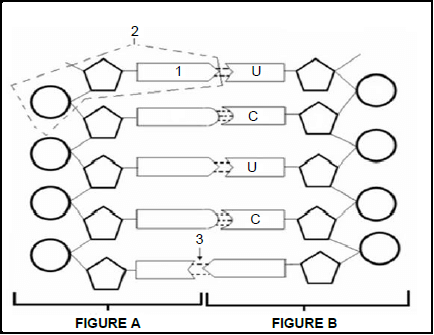
Which of the following combinations correctly identifies the parts of the above molecule?
FIGURE B | Molecule 1 | Molecule 2 | Bond 3 | |
| A | DNA | Cytosine | nitrogenous base | Weak Hydrogen |
| B | DNA | Adenine | nucleotide | Sugar Phosphate |
| C | RNA | Adenine | nucleotide | Weak Hydrogen |
| D | RNA | Thymine | nitrogenous base | Weak Hydrogen |
QUESTIONS 1.1.3 and 1.1.4 refer to the diagram below.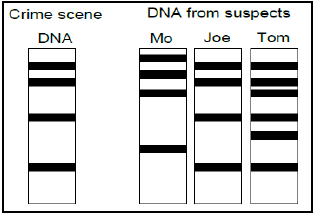
1.1.3 The result of the procedure shown above is called …
- cloning.
- DNA replication.
- fingerprinting.
- DNA profiling.
1.1.4 Study the list below:
- Paternity testing
- Matching of tissue for organ transplants
- Identification from fingerprints
- Curing genetic disorders
Which combination shows the CORRECT uses of the procedure shown in the diagram above?
- (i), (ii), (iii) and (iv)
- Only (i), (ii) and (iv)
- Only (i), (ii) and (iii)
- Only (i) and (ii)
1.1.5 When gene flow between two populations is stopped, the following is said to have happened:
- Speciation
- Adaptation
- Resistance
- Variation
1.1.6 Which of the following is an example of artificial selection?
- DDT resistance in mosquitoes
- Breeding of cows to increase milk production
- Antibiotic resistance in bacteria
- Development of a different species of Galapagos finch
1.1.7 The diagram below represents three species (A, B and C) which each live on a different island, separated by the sea.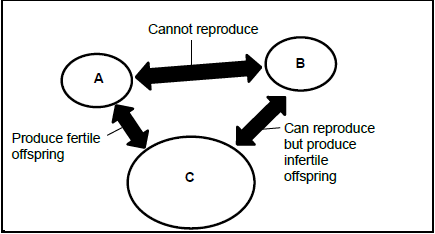
Which ONE of the following statements is correct?
- All three populations are different species
- Populations B and C are different species and A and B are the same species
- Populations A and C are the same species and B and C are different species
- All three populations are the same species
1.1.8 The forelimbs of vertebrates, as shown below, are an example of …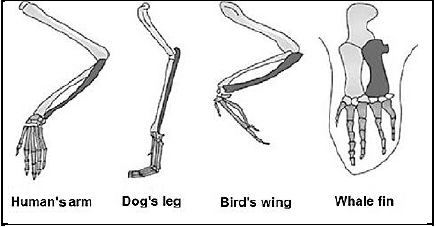
- vestigial structures.
- homologous structures.
- analogous structures.
- convergent evolution.
1.1.9 The diagram shows homologous chromosome pair number 3 from each of four fruit flies. The alleles for antenna shape (normal or abnormal) and body pattern (with stripes or without stripes) are indicated on the chromosomes.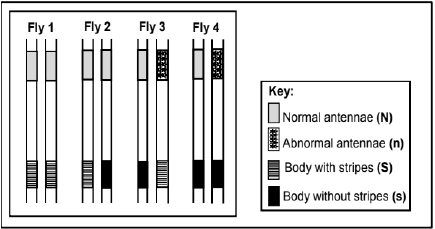
Which fly is homozygous for antennae shape and heterozygous for body pattern?
- Fly 1
- Fly 2
- Fly 3
- Fly 4
1.1.10 A hummingbird uses its long beak to feed on the nectar in flowers. According to Gould and Eldridge’s theory of punctuated equilibrium, the long beak of the hummingbird developed …
- rapidly over a short period of time.
- because the more the hummingbird used its beak, the longer it grew.
- because their beaks have been constantly changing all the time.
- gradually over a long period of time.
(10 x 2) (20)
1.2 Give the correct biological term for each of the following descriptions. Write only the term next to the question numbers (1.2.1‒1.2.8) in the ANSWER BOOK.
1.2.1 Alternate forms of the same gene
1.2.2 Natural shape of the DNA molecule
1.2.3 Stage in the cell cycle when DNA replication occurs
1.2.4 Organisms with similar characteristics which live in the same habitat and interbreed freely to produce fertile offspring
1.2.5 Phase in meiosis when crossing over occurs
1.2.6 The diagrammatic representation showing possible evolutionary relationships among different species
1.2.7 The study of past and present distribution of individual species across the world
1.2.8 The process by which all individuals of a particular species die out so that not even a single one exits (8 x 1) (8)
1.3 Indicate whether each of the statements in COLUMN Ι applies to A ONLY, B ONLY, BOTH A and B, or NONE of the items in COLUMN ΙΙ. Write A only, B only, both A and B, or none next to the question numbers (1.3.1‒1.3.3) in the ANSWER BOOK.
COLUMN Ι | COLUMN ΙΙ | ||
1.3.1 | Scientist who only studies fossils | A: | Palaeontologist |
B: | Archaeologist | ||
1.3.2 | Needed for natural selection to | A: | Variation |
occur | B: | Competition | |
1.3.3 | Reproduction isolating barrier | A: | Breeding at different times of the year |
B: | Infertile offspring |
(3 x 2) (6)
1.4 The diagram below represents the model of DNA proposed by scientists in 1953.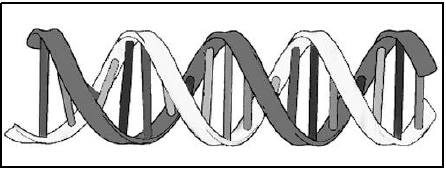
1.4.1 Name the scientists who first published the structure of DNA. (2)
1.4.2 What is the natural shape of DNA? (1)
1.4.3 Give TWO functions of DNA. (2)
1.4.4 Where is DNA found in the human cell? (2)
1.4.5 Name the other scientist that was awarded the Nobel Prize for the discovery of the structure of DNA. (1)
1.5 In a plant species two characteristics, flower colour and plant height, were studied. Each of these characteristics has two variations: flowers may be red or white in colour and the plants may be tall or short.
When two plants that are heterozygous for flower colour and height were crossed, 9 offspring were red and tall, 3 were white and tall, 3 were red and short and 1 was white and short.
The alleles for each characteristic are shown in the table below.
CHARACTERISTIC | DOMINANT ALLELE | RECESSIVE ALLELE |
Flower colour | F | f |
Plant height | H | h |
1.5.1 What is the term for a genetic cross involving two characteristics? (1)
1.5.2 Give the:
- Dominant phenotype for flower colour (1)
- Genotype of a white flowering, short plant (2)
- Phenotype of a plant that is heterozygous for flower colour and homozygous dominant for plant height (2)
- Possible gametes of a heterozygous red, heterozygous tall plant (2)
TOTAL SECTION A: 50
SECTION B
QUESTION 2
2.1 Study the diagram below.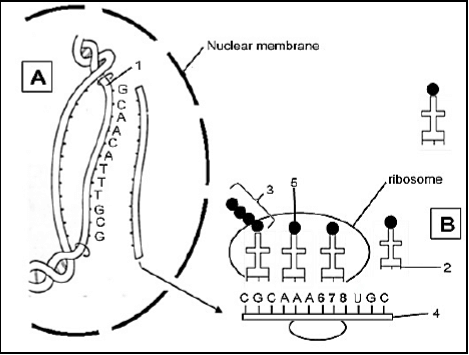
2. 1.1 Name the process represented by A and B combined. (1)
2. 1.2 Where in the cell does process B occur? (1)
2. 1.3 Identify the following:
- Molecule 1 (1)
- Polymer 3 (1)
2. 1.4 Give the correct base sequence to replace numbers 6, 7 and 8. (2)
2. 1.5 Write down the anticodon at label 2. (1)
USE THE TABLE BELOW TOGETHER WITH THE ABOVE DIAGRAM TO ASWER THE FOLLOWING QUESTIONS
| ANTICODONS OF tRNA AND THE CORRESPONDING AMINO ACIDS THAT THEY CARRY | |
| tRNA ANTICODONS | AMINO ACIDS |
| UUU | Lysine |
| ACA | Cysteine |
| GCA | Arginine |
| GUU | Glutamine |
| CCA | Glycine |
| AAA | Phenylalanine |
2.1.6 What is the DNA base triplet for Glycine? (2)
2.1.7 Name the amino acid found at label 5. (1)
2.1.8 Explain how the composition of the protein molecule would change if the base sequence of the second codon on molecule 4 (from the left)
was UUU instead of AAA. (3)
2.2 ‘Blue people’ is a genetic disorder caused when a person does not produce the enzyme that converts methemoglobin (which is blue) into haemoglobin (which is red). This results in high levels of methemoglobin in the blood. It causes the skin to turn blue, the lips purple, and the blood chocolate brown.
The diagram below shows members in a family who have blue skin. The genotype of some members of the family are known and indicated on the diagram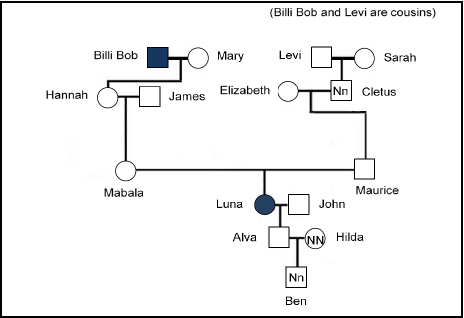
[Adapted from <htpp://ghr.nlm.nih.gov;indiana.edu/;NCBI1000Genomes Browser.]
2.2.1 Name the type of diagram shown above. (1)
2.2.2 Give the:
- Phenotype of Luna (1)
- Genotype of Hannah (1)
2.2.3 Is this disease caused by a dominant or recessive allele? (1)
2.2.4 Give a reason for your answer in QUESTION 2.2.3. (2)
2.2.5 Mabala and Maurice both have normal skin colouring. Using a genetic cross show how it is possible for their son Luna to be blue. (7)
2.3 Read the following passage.
Antarctic fish have evolved to live in the freezing waters of the Southern Ocean. They live in waters that are well below 0°C. Normally cells would freeze and burst at this temperature, killing the fish. Antarctic fish have developed proteins that act as antifreeze. These antifreeze proteins help the fish avoid freezing in their icy habitats by stopping the formation of ice crystals in the cells. These antifreeze proteins could also be commercially important. Scientists could use these antifreeze protein genes to engineer cold resistant plants or they could be used when preserving food at very low temperatures. They prevent ice crystals from forming and ruining the food. Investigators have already successfully introduced fish antifreeze proteins into yeast and bacteria through recombinant DNA technology. They can use these bacteria and yeast to produce large quantities of antifreeze proteins. |
2.3.1 Describe how Antarctic fish may have developed antifreeze proteins through natural selection. (5)
2.3.2 Name the process by which the genetic makeup of an organism is altered to include a new characteristic. (1)
2.3.3 Give TWO ways that these antifreeze proteins have been used commercially to benefit humans. (2)
2.3.4 Briefly describe how antifreeze protein is produced through recombinant DNA technology with bacteria. (5)
2.3.5 Give ONE reason why using antifreeze proteins in plants could be ethically wrong. (1)
[40]
QUESTION 3
3.1 Zebra fish come in many different colours. Emihle bought a blue male (BB) and a red female zebra (RR) fish for her fish tank. The offspring that were born were all blue and red striped.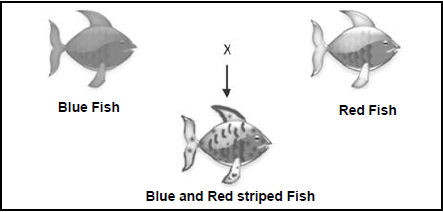
Later, Emihle decided to have a second fish tank and breed two blue and red striped fish with each other. There were 20 offspring born in total and they had three different colours: blue, red and blue and red striped.
3.1.1 Name the type of dominance shown in the above example. (1)
3.1.2 Explain the answer given in QUESTION 3.1.1. (2)
3.1.3 Draw a table showing the number of offspring of the different genotypes from Emihle’s second breeding. (5)
3.1.4 What should be the genotype(s) and phenotype(s) for the parent fish if Emihle wanted only offspring that were red? (2)
3.2 Read the following passage.
Many athletes have to train hard to build muscle. Muscle is a protein and is therefore formed by protein synthesis. Athletes need to eat and train to ensure optimal Muscle Protein Synthesis (MPS). They always want to know how much protein they must eat to build bigger muscles.
Scientists carried out an investigation to determine the optimal daily protein (in grams) needed for maximal increase in Muscle Protein Synthesis.
The investigation was carried out as follows:
- They studied 100 bodybuilders
- Each bodybuilder was given the same daily weightlifting exercise programme
- All athletes were fed the measured protein meal straight after exercising
- Their MPS was recorded 4 hours after exercising
The graph below shows the results of the investigation. These results were similar to two other investigations carried out by other scientists.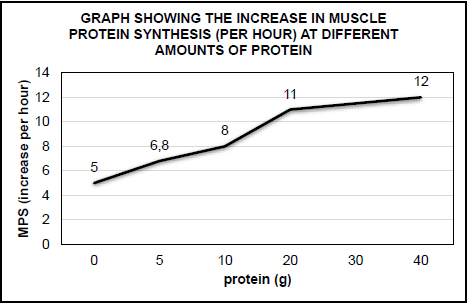
The conclusion reached by the scientists was as follows:
The optimal daily protein needed for maximal increase in Muscle Protein Synthesis is 20 g.
3.2.1 State the:
- Dependent variable (1)
- Independent variable (1)
3.2.2 Give TWO planning steps that investigators would need to follow. (2)
3.2.3 Give reasons why this investigation can be considered reliable. (2)
3.2.4 Calculate percentage increase in MPS from 20 g to 40 g. (2)
3.2.5 Using the data provided, suggest why the scientists’ conclusion stated that 20’g of protein was the optimal amount of protein needed daily for
increased Muscle Protein Synthesis. (2)
3.3 The diagram shows one way that stem cells can be produced from human embryos.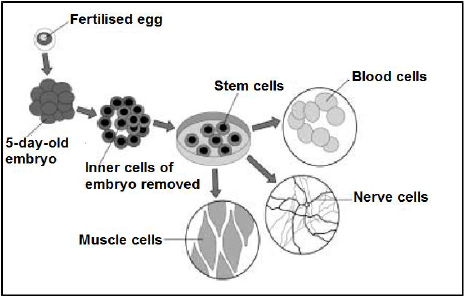
3.3.1 What are stem cells? (2)
3.3.2 Give TWO sources of stem cells other than human embryos. (2)
3.3.3 Give ONE medical condition that can be treated by using nerve cells grown from stem cells. (1)
3.4 Human blood type is an example of multiple alleles.
3.4.1 Why are blood types an example of multiple alleles? (2)
3.4.2 Give the possible genotypes for a man who is blood type B. (2)
3.4.3 If a man has blood group B and a woman has blood group A, explain how it is possible to have a child who has blood group O. (DO NOT
draw a genetic diagram.) (3)
3.5 The diagrams below show the Phiomia, an ancestor of the elephants and a modern African elephant. The Phiomia lived 35 million years ago. Both the Phiomia and modern African elephant reach up into trees to get leaves to eat.
3.5.1 Explain how Jean-Baptiste Lamarck would explain how the modern African elephant developed a long trunk. (5)
3.5.2 Give TWO reasons why Lamarck’s theory is no longer accepted today. (2)
3.5.3 Give ONE similarity between Lamarck’s theories and Darwin’s theory of natural selection. (1)
[40]
TOTAL SECTION B: 80
SECTION C
QUESTION 4
Discuss the composition of the human karyotype. Also explain why meiosis is important and how non-disjunction during meiosis can affect humans.
Content: (17)
Synthesis: (3)
NOTE: NO marks will be awarded for answers in the form of flow charts, tables or diagrams.
TOTAL SECTION C: 20
GRAND TOTAL: 150